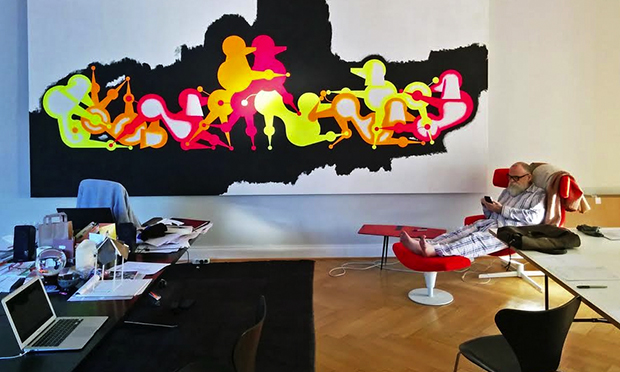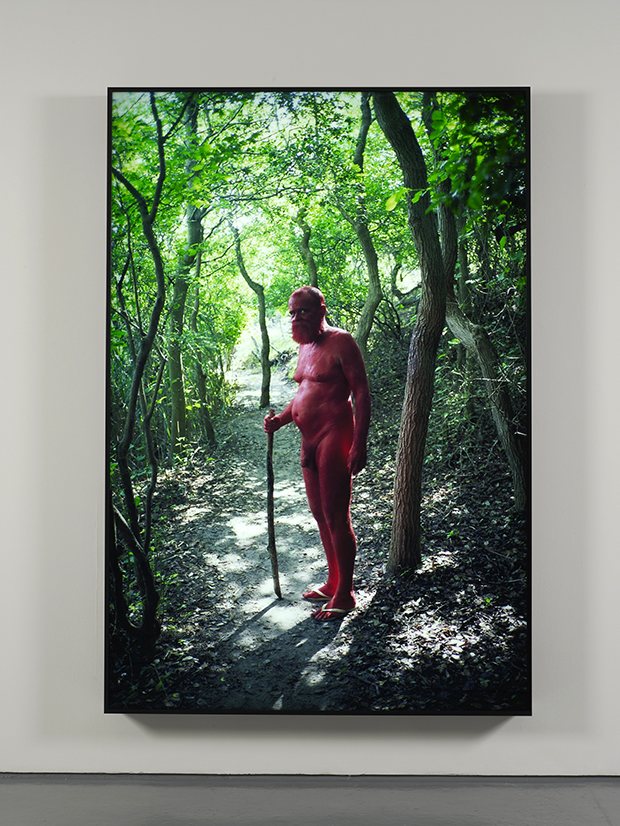
Bethnal Green’s Maureen Paley is the setting for AA Bronson: Hexenmeister, an exhibition by Canadian artist AA Bronson. The work is on display across three rooms, with each room corresponding to the three strands that characterise the artist’s long and varied career: as a radical collaborator with the group General Idea and others; as an artist invested in spirituality, shamanism and the occult; and as a curator, archivist and writer engaged with the many iterations of gay life and subculture.
Though small, the exhibition offers an illuminating insight into the work of an artist who has consistently highlighted new ways for art to be made and distributed, and who continues to challenge orthodox notions of sexuality, ageing and authorship.
As a young man in the 1960s Bronson embraced the hippie ideal and dropped out of his university architecture course in order to create alternative structures for living and creating. Alongside friends and fellow art-school dropouts he formed a commune, free school and underground newspaper in Vancouver, open to all and working on the basis of collective decision making.
This early experience of working within the framework of an open door, consensus-based system led on to his now famous work with Jorge Zontal and Felix Partz in General Idea.
A type of collaborative artistic identity, General Idea allowed Bronson, Zontal and Partz to share their lives and art, becoming, as Bronson remembers, “one person” over their 25-year collaboration. The three artists, living together and working as one, produced countless paintings, sculptures and installations, as well as public art in the forms of billboards, posters and prints.

From 1987 this public work in particular began to react to the AIDS crisis that was then decimating the gay communities of their New York base, raising awareness of the disease and highlighting the ignorance and negligence of contemporary societal institutions.
In the ground floor white cube that displays Bronson’s collaborative work here in Bethnal Green, the black canvas Black AIDS (prototype) from 1991 reflects this period of General Idea’s work. In the solid black painting an AIDS logo is hidden and unseen within the block of negative colour, its message as obscured and unreadable as information then was.
When in 1994 both Zontal and Partz died of an AIDS related illness, Bronson emerged as a solo artist, at first engaging with his own sense of loss and directly with the horror of the crisis. His work of this time has lost none of its potency, nor has Bronson mellowed in his commitment to artistic expression.
In 2010, the censorship of a film by David Wojnarowicz caused Bronson to request that his deathbed portrait of Partz be withdrawn from the Smithsonian exhibition ‘Hide/Seek’, in solidarity against censorship and the prejudice around work that fearlessly engages with AIDS and its legacy.
In later solo work Bronson also explores spirituality, manifested in his interest in the magical and occult. The large format photograph Red (2011) demonstrates this performative interaction with his own history and historical gay identity as he wanders the cruising woods of Fire Island as a red-painted apparition, documented by his collaborator, Ryan Brewer.
Placed alongside Red and at the centre of the exhibition is Treehouse (2015), a tent with a frame carved from a single ash tree and walled in hand-woven linen. This new work rises up out of dirt in the gallery floor as an inviting private space of reflection or a place for potential performance.
The third room reflects Bronson’s parallel and interwoven career as a curator, editor and archivist, best exemplified by his founding of the NY Art Book Fair in 1995. The room displays the Bronson curated mini-exhibition Queer Zines, a spread of self-produced and independent magazines that deal with gay life, sex and communities across Europe and America.
Alongside often-explicit images and descriptions of their sexuality, these zine writers document scenes, party spaces and artists to reveal the links between gay and queer lifestyles and punk, lo-fi and other DIY subcultures.
As Bronson himself writes: “They reveal a community in constant communication.” In much the same way, this exhibition showcases an artist in constant communication with the radical, the challenging and the subversive.
AA Bronson: Hexenmeister
Until 31 May
Maureen Paley
21 Herald Street, E2 6JT
maureenpaley.com
